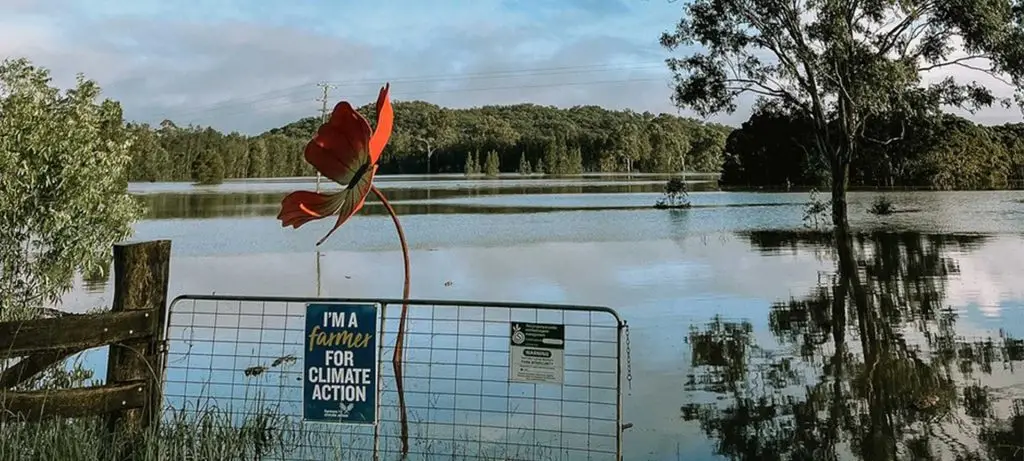Climate change is a phenomenon that affects operators across the entire agricultural industry. There is no sector within agriculture that will not be negatively affected if the earth warms beyond the 1.5-degree mitigation target outlined in the Paris Agreement in 2015, and reaffirmed at the Sharm el-Sheikh Conference in 2022.
Based on current projections, many countries, including Australia, will not meet their nationally determined contributions to the Paris Agreement. Failure to meet these commitments is likely to have a major impact on Australia’s climate and agricultural businesses.
Before and after the Paris Agreement, Australia has seen natural disasters exacerbated by climate change. Severe flooding in Northern Queensland in 2019 had a significant impact on livestock producers, with an estimated 600,000 cattle lost[1].
In the summer of 2019/20 New South Wales, Victoria, South Australia, and Tasmania were affected by severe bushfires that caused widespread damage to organic and non-organic operators. Over the summer of 2021/22 much of the east coast of Australia was hit by significant flooding, affecting communities across New South Wales, Queensland, and Victoria.
Events such as these highlight the increasing severity of drought and floods across much of Australia, the rising threat of climate change and the impact it can have across the agriculture industry.
An estimated 13% of greenhouse gas emissions in Australia are currently attributed to the agriculture industry. Synthetic nitrogen fertilisers alone account for around 67% of global cropping emissions[2]. Within Australia, the combined scope of pesticides and fertiliser contributed to a total of 48.3% grain emissions per tonne[3]. Soil erosion has also caused carbon loss from soils into the atmosphere. This, combined with the use of synthetic nitrogen fertilisers that are common in conventional farming further contributes to climate change.

Organic operations across the agricultural industry will have an important role to play as Australia and the world work to mitigate climate change. Current conventional agricultural practices are not part of the solution, rather, they are part of the problem. Instead of mitigating climate change, conventional agriculture is a net producer of greenhouse gas emissions both directly through depleting soil carbon stocks, emitting nitrous oxide (N2O), and indirectly through land-use change[4]. The intensification of livestock production has exacerbated release of the greenhouse gas methane (CH4). Research shows most agricultural soils have lost from 30% to 75% of their original soil organic carbon due to current unsustainable conventional agricultural practices[5].
Apart from the ocean, soil is the second largest carbon sink. Organic farming systems have been shown to emit up to 40% less carbon emissions than conventional in numerous long-term trials[6]. Organic agriculture focuses on soil health, ground cover, crop rotations and minimal inputs without the use of synthetic fertilisers and pesticides. Data from farming systems and pasture trials around the globe show that agriculture could sequester more than 100% of current annual carbon dioxide emissions, provided there was a strategic shift toward widely available and inexpensive organic management practices. These practices work to maximise carbon fixation while minimising the loss of that carbon once returned to the soil, reversing the greenhouse effect[7].
Organic production methods such as cover crops, keeping ground cover, green manure, stubble retention, crop rotations and controlled grazing all work to increase soil carbon. However, plant photosynthesis ultimately converts atmospheric Carbon Dioxide (CO2) into organic (carbon-based) compounds. Carbon is retained in the plant biomass and delivered to the soil in plant residues and root exudates. As the soil life digests plant residues, about 15-35% of the annual plant carbon input remains in the soil beyond the current season as soil organic carbon, making up most soil organic matter[8].Thus, in all natural and agricultural ecosystems, the living plant is the primary source of soil organic carbon and in turn carbon sequestration.
The soil microbiome mediates soil carbon sequestration. Research shows a direct link between the application of synthetic nitrogenous fertilisers and a decline in soil carbon due to a rapid decay of the organic matter. For every 1% increase in soil organic matter, the water holding capacity of the land increases by over 354 thousand litres per hectare (USDA). As a result, long term produce yields are up to 40% higher in times of drought on organic farms[9]. In addition, synthetic pesticides and nitrogen fertiliser are the largest energy inputs within non-organic agriculture. Organic systems require the constant rotational cultivation of leguminous crops and symbiotic use of livestock, instead of the addition of artificial nitrogen inputs. These organic systems are complementary to the soil carbon sequestration, plant health and farm efficiency, which in turn has a positive influence on climate change.
The Department of Agriculture, Fisheries and Forestry Budget Statements 2021-22 outlines five outcomes that it is responsible for as part of its strategic direction. Outcome 1 states the department has responsibility to:
“conserve, protect and sustainably manage Australia’s biodiversity ecosystems, environment and heritage through research, information management, supporting natural resource management, establishing and managing Commonwealth protected areas, and reducing and regulating the use of pollutants and hazardous substances, and coordination of climate change adaptation strategy and climate change science activities”.
The change in government has brought a renewed commitment to a 43% target for reduced emissions by 2030. Despite this, the 2022 October budget from the government included no direct references to organic as part of the budget. AOL believes there is more potential to work with the government to reflect the important role organic farming has in reducing the impact of climate change.
As the peak body for the organic agriculture industry, AOL is in a unique position because its members work across the entirety of the agriculture industry. Its members are not only farmers and producers, but also manufacturers, wholesalers, and retailers. AOL is well positioned to continue working with the government and the department to help achieve these stated outcomes.
As the Department and Government looks for ways to lower emissions and reduce the impacts of climate change, opportunities exist within the promotion and development of organics to help achieve these goals.
Governments at Federal and State/Territory level can do more to assist non-organic operators looking to transition to organic. The process to become an organic operator can take up to three years and relies on an audit process that can be time consuming and expensive. Tasmania is currently the only state in Australia which provides grants to operators to begin this process[10]. As the organic industry continues to grow, AOL believes there is an opportunity to build this program and replicate it across Australia to help assist in the fight against climate change.
Research in organic production can accelerate the growth of the industry and expand organic’s ability to mitigate climate change. Further research and long-term organic farming trials to substantiate the benefits of organic practices in an Australian context are needed.
Because the organic sector is spread across all agricultural industries, research priorities of the organic sector are not prioritised by the rural research development corporations (RDCs). As a result, larger organic industry questions remain unanswered and there are limited resources to tailor to every soil type, crop type, industry or region of operation.
AOL is determined to ensure organic research priorities are addressed through collaboration with RDCs, universities, industry, and government grants. This research will have additional benefits for the non-organic industry and across the agricultural sector, as it will help to foster a greater understanding of how organic practices can be easily deployed to mitigate climate change impacts.

AOL notes many agricultural sectors have introduced strategies and plans to combat climate change. For example, both the meat and dairy industries have enacted comprehensive plans that detail their specific strategies.
Similar to the lack of announcements for organic in the October budget, the 2022-23 departmental budget statement released by DAFF includes no references to organic in the sustainability reports across the broader agriculture industry. They fail to highlight the potential of organic farming practices to help improve the sustainability of each industry.
As the peak body for the organic industry, AOL supports the goals of these sustainability reports and believes organic operators who work within these industries can play an important role in their success.
More broadly, the National Farmers’ Federation (NFF) has publicly stated its support for net-zero emissions by 2050, with caveats to ensure operators working in agriculture are not disadvantaged.
AOL is broadly supportive of this policy and believes there is scope for the organisation to promote organic farming and products as a viable tool to help reach this target. As a member of the NFF, AOL will continue to work with the body to promote the benefits of organic farming as part of achieving the target of net-zero emissions by 2050.
AOL is supportive of all attempts by agricultural industries to proactively combat climate change. Organic operators in these sectors have an important role to play in encouraging these goals and providing vocal support around the benefits that increased soil carbon and quality has on production, the environment and climate.
[1] Crowley, G, and Preece, N.G (2019) Catastrophic Queensland floods killed 600,000 cattle and devastated native species, The Conversation, 23 August. Available at https://theconversation.com/catastrophic-queensland-floods-killed-600-000-cattle-and-devastated-native-species-120753 (Accessed 21 October 2021).
[2] Hanqin Tian et.al.: A comprehensive quantification of global nitrous oxide sources and sinks. Nature, 2020. Summary Doi.org/10.1038/s41586-020-2780-0.
[3] Available at: https://publications.csiro.au/publications/publication/PIcsiro:EP2022- 0163#:~:text=Total%20GHG%20emissions%20associated%20with,compared%20to%20other%20exporting%20countries.
[4] 3. Lal, R. Soil carbon sequestration to mitigate climate change. Geoderma 123, 1–22 (2004).
[5] Lal, R., Follett, R. F., Stewart, B. A. & Kimble, J. M. Soil carbon sequestration to mitigate climate change and advance food security. Soil Sci. Dec. 2007 172, 943–956 (2007).
[6] Moyer, J, Smith, A, Rui, Y and J, Hayden. 2020 Regenerative Agriculture and the Soil Carbon Solution. Rodale Institute, September 2020. Available at https://rodaleinstitute.org/education/resources/regenerative-agriculture-and-the-soil-carbon-solution/, (Accessed 21 October 2021).
[7] Regenerative Organic Agriculture and Climate Change:A Down-to-Earth Solution to Global Warming. Available at: https://rodaleinstitute.org/wp-content/uploads/rodale-white-paper.pdf.
[8].Weil, Raymond & Brady, Nyle. (2017). The Nature and Properties of Soils. 15th edition.
[9] Exwood, David, 2022 Improving soil organic matter and water holding capacity, NFU. Available at: https://www.nfuonline.com/updates-and-information/soil-organic-matter-and-increased-water-holding-capacity/#:~:text=Andy%20Neal%20at%20Rothamsted%20Research,to%20a%20depth%20of%2030cm’.
[10] Department of Primary Industries and Water 2020, New program to drive growth in organic production, Government of Tasmania, Hobart, viewed 21 October 2021, https://www.premier.tas.gov.au/releases/organics_growing_opportunities_for_tasmanian_farms_and_food_businesses.
Australian Organic Limited (AOL) is the peak body for the organic industry.
AOL acknowledges the Traditional Custodians of the land on which we operate, the Turrbal and Yuggera people. We extend our respect to Elders past, present and emerging.